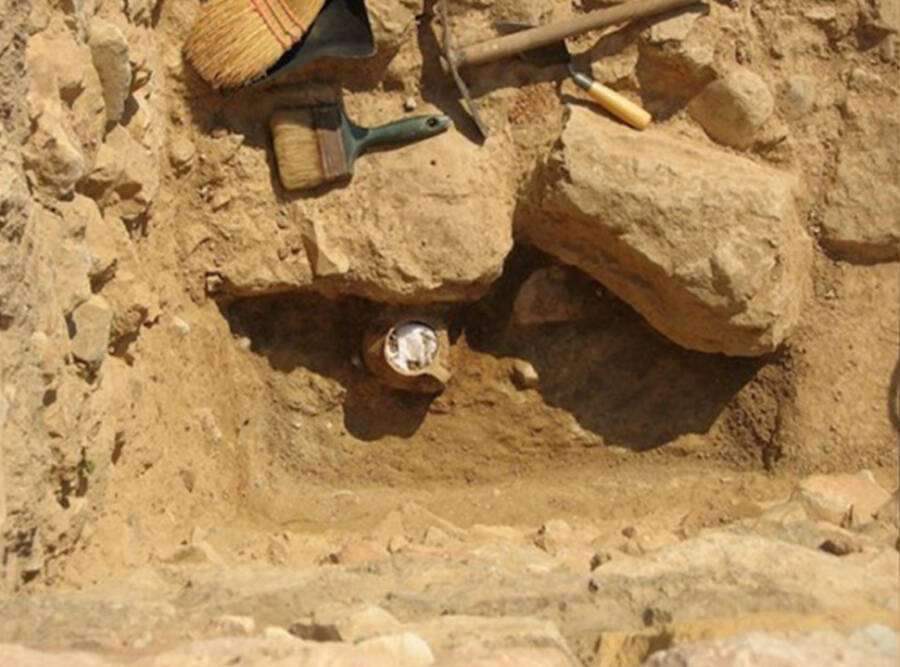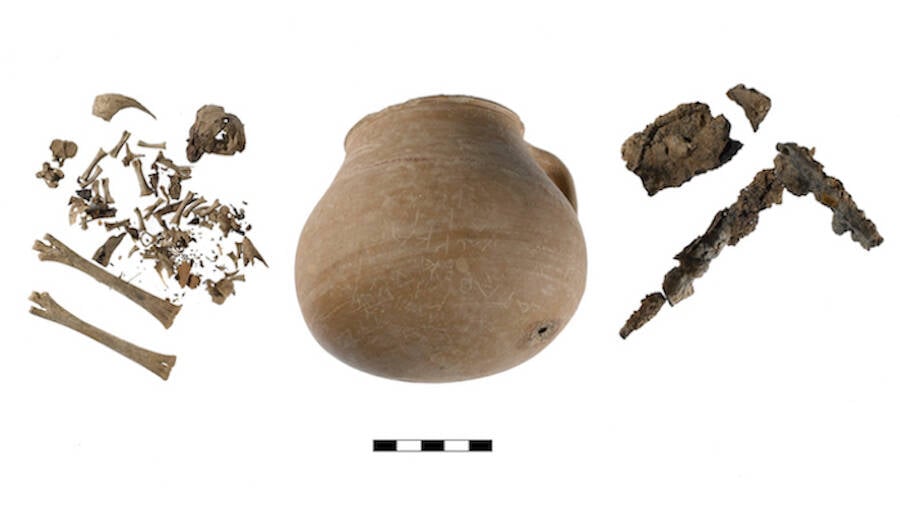The jar contained the dismembered head and feet of a seven-month-old chicken and was pierced with a nine-inch long iron nail before being buried at the commercial heart of ancient Athens.

Athenian Agora ExcavationsArchaeologists discovered the 2,300-year-old Greek curse jar during an excavation at the Athenian Agora.
In 2006, archaeologists in Athens made the stunning discovery of a 2,300-year-old jar holding the bones of a dismembered chicken. Most remarkable was that 55 names were inscribed on the exterior of the jar (or chytra). Researchers have just decoded the message and believe these people were the targets of an ancient curse.
Dr. Jessica Lamont of Yale University has now detailed the find for the first time. The jar was pierced with an iron nail and buried beneath the Agora’s Classical Commercial Building with a coin. Researchers have dated the jar to between 325 and 270 B.C., shedding new light on the use of magic in ancient Greece.
“The ritual assemblage belongs to the realm of Athenian binding curses and aimed to ‘bind’ or inhibit the physical and cognitive faculties of the named individuals,” the study published in Hesperia explained.
“All exterior surfaces of the chytra were originally covered with text; it once carried over 55 inscribed names, dozens of which now survive only as scattered, floating letters or faint stylus strokes,” wrote Lamont, adding that nails “had an inhibiting force and symbolically immobilized or restrained the faculties of the victims.”

Athenian Agora ExcavationsMore than 30 of the names remain legible, while the rest have largely faded.
The assemblage of the items is suggestive of the makers’ seriousness of intent. They sealed the jar’s circular opening with the head of the chicken. And the nine-inch nail had been rammed through the bottom of the jar and upwards — piercing the chicken’s legs and head. The coin had been fused to the nail head.
The chicken was found to have been no older than seven months when it was killed. Lamont believes that this was likely intentional. Those aiming to strengthen the curse wanted to imbue “the chick’s helplessness and inability to protect itself” into the vessel and thereby into the victims.
“By twisting off and piercing the head and lower legs of the chicken, the curse composers sought to incapacitate the use of those same body parts in their victims,” Lamont said.
The handwriting on the jar suggests that at least two different people were involved in the carvings. Lamont explained that this is “largely unprecedented in Greek curse tablets.” Ultimately, more than 30 names are legible to this day, as are the words “we bind.”

Athenian Agora ExcavationsThe large iron nail that pierced the chicken held inside of the jar.
Lamont has several theories about the purpose of the curse. One possibility is that it was intended to thwart corporate conflict. The building it was buried beneath was a hub of craftsmanship and used from sunrise to sunset by ancient workers.
“The sheer number of names makes an impending lawsuit the most likely scenario,” said Lamont, adding that “curse composers might cite all imaginable opponents in their maledictions, including witnesses, families and supporters of the opposition.”
“The curse could have been created by craftspersons working in the industrial building itself, perhaps in the lead-up to a trial concerning an inter-workplace conflict,” wrote Lamont.

Athenian Agora ExcavationsThe chicken bones, jar, and nail, which was found pierced through the small hole at the base of the jar.
Moreover, the fact that the jar was buried beneath the site of an industrial hub supports Lamont’s theory that the curse composers believed it would have more power by being in closer proximity to its targets.
Some of the names on the jar are attested to in other archaeological finds, making them known citizens of Athens around the time of the jar’s burial. And about one-third of the names are women. The dating of these artifacts, meanwhile, has placed them squarely into the timeframe of Alexander the Great’s death in 323 B.C., when many rival factions were vying for power.
Lamont explained that it was “a period plagued by war, siege and shifting political alliances,” which might have led these particular curse composers to paralyze their competition.
Though curses are widely attested to, and many have been discovered, it is the remarkable preservation, unique placement, and number of recognizable names that make this discovery so important. And it shows just how powerful magic was for ancient Athenians.
According to Lamont, the discovery at the Agora “offers unparalleled evidence for the practice of ‘magic’ in the heart of Athens.”
After reading about the ancient curse jar uncovered in Greece, learn about the Ancient Greek “curse tablets” discovered in a well in Athens. Then, read the five most important battles of the ancient Greek wars.






